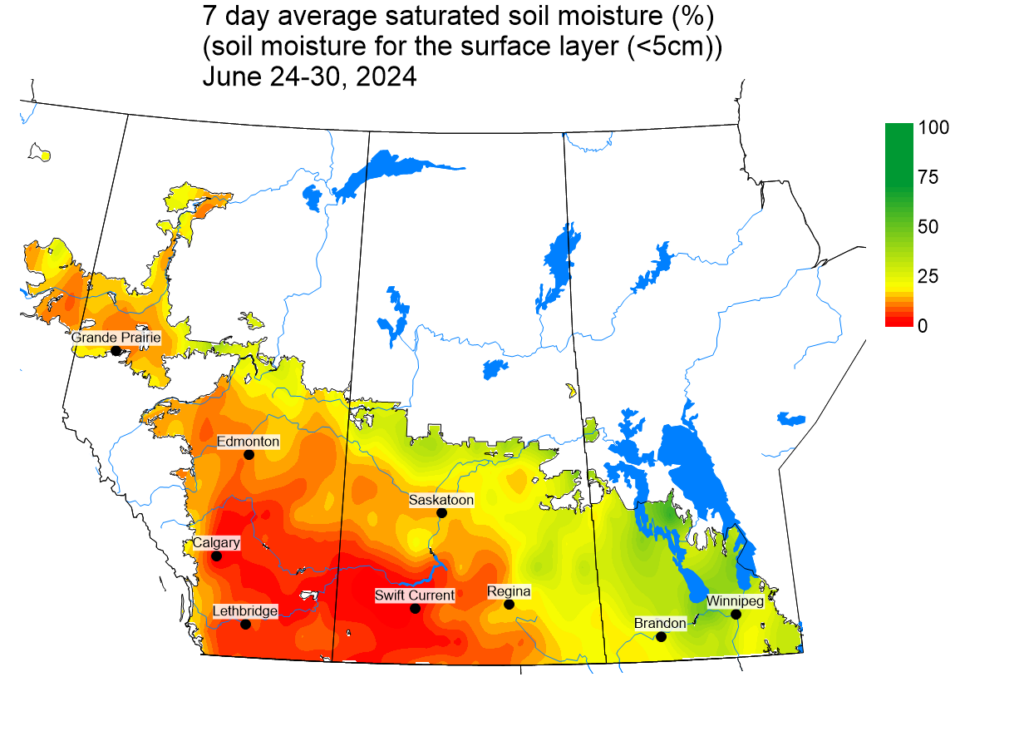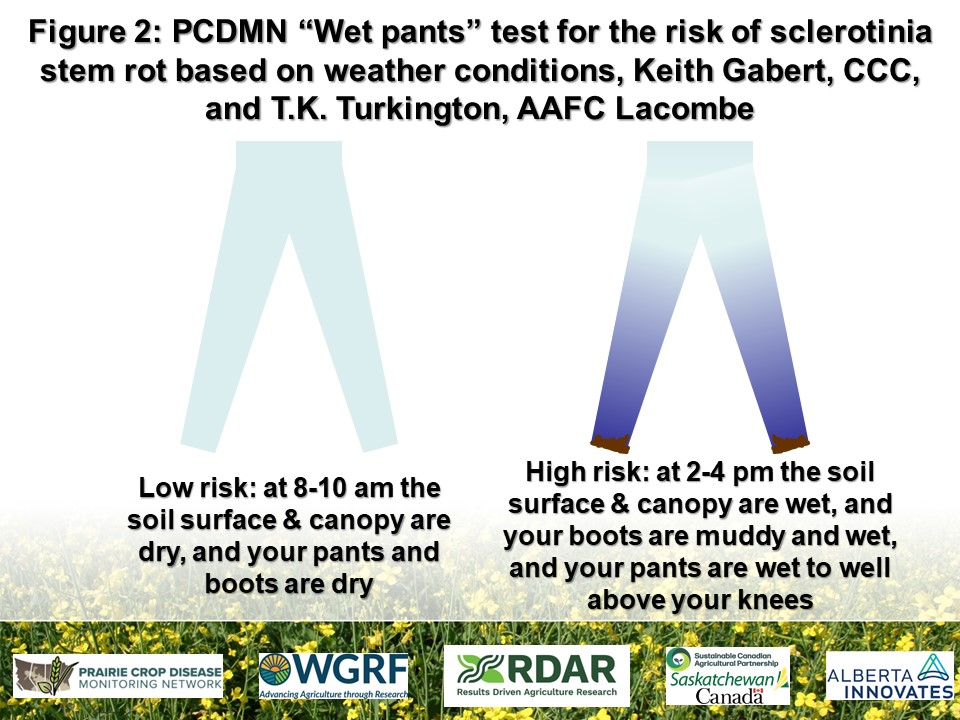This is the second weekly PCDMN soil moisture update in relation to the risk of sclerotinia sclerotial germination and potential risk of stem rot of canola. For details on the background of these updates please visit the first weekly update for 2024.
Soil moisture values, particularly near the soil surface, can impact on sclerotial germination. Figure 1 presents data to show soil moisture levels (averaged for June 24-30, 2024) in the top five centimeters of soil in western Canada. Driest soil moisture conditions were observed for western regions of Saskatchewan and Alberta. Soil moisture values were greatest for Manitoba and the Parkland region of Saskatchewan. The data is produced from passive microwave satellite data collected by the Soil Moisture and Ocean Salinity (SMOS) satellite and converted to soil moisture using the SMOS soil moisture processor. The data are produced by the European Space Agency. Satellites are used to sense the strength of radiation emitted from the surface of the earth. There is a strong difference in the signals emitted by dry soil and wet soil. This relationship is used to calculate surface soil moisture using a model that incorporates land cover, vegetation content, surface roughness, soil texture and other factors that influence the satellite sensor. The satellite collects data every one to three days over Canada (Satellite Soil Moisture – agriculture.canada.ca).
Prairie canola growth stages for 2024 are variable depending on the Province, region, and seeding date. In many regions crops are moving from the rosette stage to stem elongation and are beginning to flower or have moved into the early bloom stage. For wetter regions (Figure 1), conditions have likely been favourable for germination of sclerotia and production of apothecia over the last 1-2 weeks. However, recent rains in drier areas will help to initiate sclerotial germination and eventual production of apothecia over the next 2-3 weeks. As of June 30, the need to scout fields for apothecia of the stem rot fungus and/or to assess in-field risk is low to moderate, although the risk is higher in regions where moisture conditions have been increased over the last 2-3 weeks, e.g. eastern Saskatchewan and Manitoba. Scouting is especially important where crop canopies have covered the soil surface for at least 2-3 weeks. NOTE: localized weather events may have resulted in rainfall in other Prairie regions. In 2006, the Canola Council of Canada and Agriculture and Agri-Food Canada co-developed a canola disease identification card that includes examples of typical stem rot pathogen apothecia along with other fungal fruiting structures that are not stem rot apothecia.
In these higher risk areas in-crop scouting for apothecia and the use of available stem rot risk assessment tools may be needed over the next 1-3 weeks as part of fungicide use decisions. Tools such as the Spornado spore trap and petal testing services (service 1 and service 2) can provide guidance related to the level of sclerotinia inoculum and stem rot risk as the crop starts flowering. Note these need to be combined with other risk tools to provide a complete picture of stem rot risk in relation to host, pathogen and environment factors, i.e. the disease triangle. If fungicides are being considered, accounting for the most common crop growth stage in a field should be considered to help guide the timing(s) used. Fortunately, most fungicide products have a window from 20-50% bloom, which represents a range of growth stages. Note available risk assessment tools will provide guidance related to stem rot risk and whether a fungicide is needed from 20-50% bloom.
On June 26, 2024, a new web-based tool from the Canola Council of Canada was recently announced that considers host, pathogen and weather related stem rot risk factors as well as a component that evaluates ROIs based on input costs, projected yields and commodity price. More information on the tool can be found at the Canola Council of Canada, along with the online tool itself.
For growers in Alberta, Ralph Wright and colleagues with Alberta Agriculture and Irrigation have added a relative humidity (RH) based tool to indicate the potential for for infection in relation to daily hours of RH above 80%. This is based on a currently available United Kingdom stem rot risk tool based on RH and other factors including aerial ascospore counts. When crops advance into flowering, Alberta growers can use the Alberta tool to complement scouting for apothecia, use of the new CCC web-based tool, and spore load assessment options.
Another straight-forward option to gauge the favourability of the weather and canopy microenvironment for stem rot is the “wet-pants test” (Figure 2), which is an approach developed by Keith Gabert, CCC Agronomist, and T.K. Turkington, Plant Pathologist, AAFC Lacombe. Here if you are scouting your field at 8-10 am in the morning and the soil surface is dry and the crop canopy is dry, this would represent canopy microenvironmental conditions that ARE NOT conducive to sclerotial germination and apothecia production, and infection of plants from ascospore-contaminated petals. Under these conditions it is likely not worthwhile to spray a fungicide, but further scouting should be done as your canola crop progresses to the full bloom stage. In addition, also look at what the other risk assessment tools are indicating. Conversely, if you are out in the crop towards late afternoon and the soil surface is very wet, your boots are muddy and your pants are wet to the knees and upwards, this would would represent canopy microenvironmental conditions that ARE conducive to sclerotial germination and apothecia production and infection of plants from ascospore-contaminated petals. Under these conditions spraying a fungicide may be worthwhile, especially if the other stem rot risk tools mentioned previously indicate a moderate to high risk. Note: the “wet pants” test may likely be useful for gauging the favourability of the weather and canopy microenvironment for cereal leaf spot and pulse canopy disease development.

Figure 1. 7 day average saturated soil moisture (%) for the surface layer (<5cm)) for the period of June 24-30, 2024.


